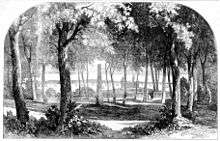Hamlet's Grave
There are two sites in Denmark presented as Hamlet's Grave (Hamlets Grav), the burial site of Amleth (Amlethus, Amlodi, Amblett), the Jutish chieftain of historical legend on whom Hamlet, the hero of Shakespeare's tragedy was based; one is in the grounds of Marienlyst Castle in Helsingør, the other is a Bronze Age tumulus in Ammelhede, Randers Municipality, Jutland.[1]
Marienlyst


In Helsingør, tradition since at least the late 18th century located "Hamlet's grave" just north of what is now Højstrup halt. Touristic interest in visiting Hamlet's Grave arose in the 1850s. By that time, a stone obelisk marked Hamlet's Grave in the park of Marienlyst Castle (56.0423°N 12.6005°E), on an old fortification on the crest of a hill.[2]
According to Jacob Riis, there were two stone obelisks erected (subsequently) at the spot, which were both eventually carried away by relic-seekers. Therefore, in 1879, J.S. Nathanson, who rented Marienlyst castle and operated a luxury hotel there from 1859 to 1896, marked Hamlet's grave with a large heap of stones. He would re-supply the stones regularly as they were carried away as relics by tourists. Nathanson's display of Hamlet's grave for the benefit of "the credulous and sentimental" and the aggressive use of the name of Hamlet in the advertisement of Hotel Marienlyst was much criticized at the time.[3]
A granite stone shaped like a sarcophagus was erected on the site in 1926, on the occasion of Helsingør's 500-years anniversary. The relief on the stone was designed by Einar Utzon-Frank. At this point, no pretense was made to the effect that the site was in any way the historical burial-place of Hamlet. Postcards of the period identify the monument as Hamlets mindesten ("Hamlet's memorial stone").[4] At a later time, a bronze plaque was added to the stone reading
- Einar Utzon-Frank, Hamlets Mindegrav, på Sarkofagen Symboler for mandlig Styrke og Jomfruelighed, 1926
- "Einar Utzon-Frank, Hamlet's memorial grave, on the sarcophagus symbols of virile strength and of virginity, 1926"
This refers to the design of Utzon-Frank's relief, showing a lion-like creature on one side (for Hamlet) and a unicorn on the other (for Ophelia).[5]
Ammelhede
On 27 April 1932, O. Løye, pharmacist at the Løveapoteket drug store in Randers, Jutland, published an article in the local newspaper in which he claimed to be able to prove that a local burial mound known as Kongshøj ("king's howe"; 56.434°N 10.221°E) was the tomb of Hamlet. The mound in question is situated in Ammelhede, the name of a pasture and farmstead in Essenbæk Sogn (formerly Sønderhald Municipality, since 2007 part of Randers Municipality). Løye interpreted the toponym as Amleds hede "Amleth's heath". In the account of Saxo Grammaticus, Amlethus dies in battle against Wiglek and is indeed buried on a plain in Jutland, which was afterwards named after him.[6]
Løye's article triggered a lively debate, including scathing criticism published in Fyns Venstreblad. On 30 April, Politiken published a sarcastic article which made the tongue-in-cheek suggestion that the people of Randers were free to exploit the theory and erect a stone to Hamlet on the mound in an attempt to draw away tourism from the much-criticized "fraudulent" monument in Marienlyst park.
The following year, on 3 September 1933, such a stone was indeed raised on the mound by the recently founded Randers tourist board (Turistforeningen), citing the support of Jørgen Olrik, curator of the Danish folklore museum, and Hans Ellekilde, archivist of the Danish folklore collection.[7] The stone is inscribed with an alliterating poem,
- Amled Ypperste / Oldtids-snille "Amled, the chieftain, craftiest of old,"
- Teed sig taabe / Til hævnens time "made himself a fool until the time of vengeance,"
- Kaaret på ting / Af Jyder til konge "Chosen as king at the thing of the Jutes,"
- Højsat han hviler / Paa Amled Hede "High-seated he rests on Amled's heath."
Excavations in 1950 established that the burial mound in fact dates to the Bronze Age.[8]
References
- A third site given the name Hamlets Grav (although it is not marketed as "Hamlet's grave" to tourists) is a Neolithic structure (c. 4th millennium BC), consisting of a long barrow with standing stones, in Odsherred Municipality, Sjælland (55.8182°N 11.6279°E).visitodsherred.dk
- "Hamlet's Grave, Elsinore" Frank Leslie's New York Journal of Romance, General Literature, Science and Art, July 1856. "Hamlet's grave is marked by a single stone obelisk, evidently of very early date; it is surrounded by tables and chairs, where citizens from Copenhagen consume beer and coffee and defile with their heeltaps the sepulchre of a king."
- Elise Lathrop, Where Shakespeare Set His Stage (1906), p. 168.)
- "Hamlets mindesten" (helsingorleksikon.dk)
- Lars Bjørn Madsen, Monumenternes Helsingør (1997), 12–14. helsingorleksikon.dk.
- Insignis eius sepultura ac nomine campus apud Iutiam exstat. "A plain in Jutland is to be found, famous for his name and burial-place." Gesta Danorum 4.2.4, trans. Oliver Elton (1905) .
- Michael Skovmand, Verdens bedst kendte dansker: Hamlet er så levende som aldre før" Archived 2014-03-06 at the Wayback Machine, Kronik, Aarhus Stiftstidende, 1 February 1992, at Department of English, University of Aarhus (in Danish) historiskatlas.dk (with a photograph of the unveiling ceremony of the monument).
- Hamlets Grav - fiktion og virkelighed at Danske Fortidsminder (in Danish).